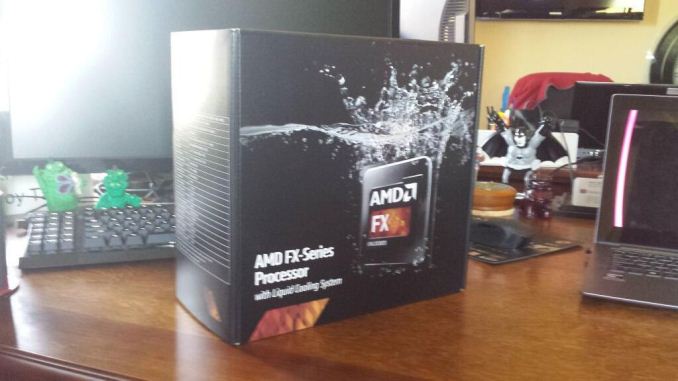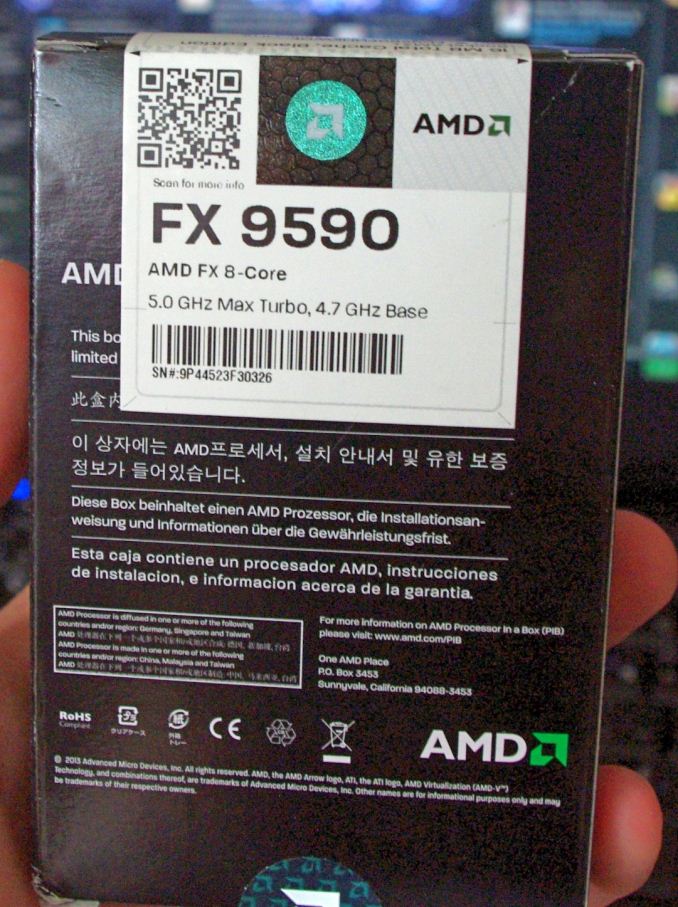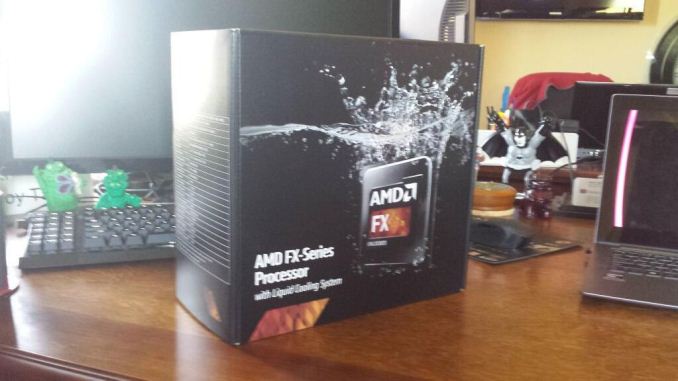AMD’s 5 GHz Turbo CPU in Retail: The FX-9590 and ASRock 990FX Extreme9 Review
by Ian Cutress on August 9, 2014 8:00 AM EST
While AMD’s FX-9590 CPU has been in systems for over a year, it suddenly comes to market as a retail package for end-users to buy with a bundled liquid cooling system. This 220W CPU that has a turbo speed of 5.0 GHz still sits at the top of AMD’s performance stack, despite subsequent improvements in the architecture since. We have decided to grab ASRock’s 990FX Extreme9 and an FX-9590 for a review to see if it still is the AMD performance CPU champion.
Spot the CPU
The story behind AMD’s fastest ever x86 CPUs is slightly odd. Two models, the FX-9590 and FX-9370, were both launched into OEM channels in June 2013. Being an OEM component, the only way to get one was in a pre-built system through a retailer, or through a bulk system integrator that had a model around one of these CPUs. Typically this is a process that is only exhibited with server class processors: from a range of CPUs being produced, only several will be available for end-users at retail because server CPUs usually go through a system builder. At the time, it seemed that AMD concerned that the high TDP of this CPU, at 220W listed, is too much for most cooling setups within a home user system and the best way to get it to consumers would be if a system builder chose the appropriate cooling for them.
As a result of this orientation of sales, AMD did not sample the media with review units. We review an AMD product typically though an AMD sourced sample. It was also noted that the OEM price for the CPU was near $900 for the FX-9590, which seemed like an excruciating amount for what was essentially a good overclocking version of the FX-8350. Several media websites were able to collaborate with system builders in order to get a chance to review the CPU, and AMD was confident in their promotion and handling of the new CPU.
Anecdotally, in my field of vision, the promotion of this CPU was relatively limited. The price was the main factor, resulting in comparative AMD/Intel systems being more power hungry on the AMD side, and substantially more expensive when put up against the latest mainstream i7 at the time. As a result, while some retailers were selling the OEM CPU at full price, some retailers decided to sell their OEM stock with a severe price cut directly to consumers, down from $900 to $390, in order to get rid of units (this is when I picked up our sample).
Due to the OEM nature of these sales to end-users, each CPU had either no warranty with AMD or a limited warranty. For the user interested in a 3-year system cycle without the fear of a bad egg, the OEM route is never a positive one.
AMD subsequently released, relatively silently, a proper package and retail version of the FX processors. It was apparent that this was in response to the OEM sales, with the retailers list ‘heatsink and fan not included’ alongside the specifications.
| AMD FX CPU Comparison | ||||||
|
FX- 4350 |
FX- 6350 |
FX- 8320 |
FX- 8350 |
FX- 9370 |
FX- 9590 |
|
| Release Date |
April 2013 |
October 2012 | October 2012 | October 2012 | June 2013 | June 2013 |
| Modules | 2 | 3 | 4 | |||
| L1 Cache (Code) | 128 KB | 192 KB | 256 KB | |||
| L1 Cache (Data) | 64 KB | 96 KB | 128 KB | |||
| L2 Cache | 4 MB | 6 MB | 8 MB | |||
| L3 Cache | 8 MB | |||||
| TDP | 125W | 220 W | ||||
| Base Frequency | 4200 | 3900 | 3500 | 4000 | 4400 | 4700 |
| Turbo Frequency | 4300 | 4200 | 4000 | 4200 | 4700 | 5000 |
| Core Name | Vishera | |||||
| Microarchitecture | Piledriver | |||||
| Socket | AM3+ | |||||
| Memory Support | DDR3-1866 | |||||
| Price (US) | $140 | $140 | $160 | $190 |
$230 $300 CLC |
$300 $370 CLC |
Since that release, AMD has not upgraded their enthusiast processor line with the latest architecture. The FX line has stayed where it is, perhaps for a number of reasons. One could speculate that releasing the next generation of FX-85xx might put them behind the FX-9590 in performance, or that the fabrication process was not suitable for a quad-module CPU with the new architecture improvements. The FX line for desktops, as far as we know, is staying at 32nm with no improvements.
Now Available
Fast forward twelve months to June 20th 2014 and Roy Taylor, AMD’s VP of Global Channel Sales tweets this innocuous picture:
Speculation was rife as to what this was. Here is a large box for an FX processor with the words ‘with Liquid Cooling System’ underneath. AMD supplied liquid cooling to the media when we reviewed the FX-8350 CPUs, the main CPU that sits underneath the FX-9590 and FX-9370, so there was an expectation that was something new.
On June 26th, the @AMDFX twitter account posted the following, confirming that this was the older FX-9590 but in a retail box with retail cooling:
To celebrate the start of ‘Round of 16’, we’re giving away eleven FX-9590 CPUs! #FXCUP pic.twitter.com/21JRaHdMq8 — AMD FX (@AMDFX) June 26, 2014
The AMD FX Processor page has been updated accordingly, showing the same render of the new box. Here we see that the liquid cooler is supplied by Cooler Master, and uses a wide range PWM fan as part of the package.
Of course, this leaves several questions unanswered: how much, when is it on sale, where is it on sale, and is it still any good? Well for the US at least, it is on sale today from Newegg at $370 with the water cooling kit, or $330 without. NCIX has it listed for CAD$500, although this is currently in ‘back stock’ mode.
The SKU to look for is the FD9590FHHKWOX, which in the UK does not seem to be on the shelves as of yet. Amusingly, when this is typed in to Google, the search engine asked me if I meant FD9590FHHKWOF, the non-CLC version.
This Review
Back when the FX-9590 was originally released alongside the FX-9370, we were unable to secure a sample from AMD and the limited availability made us feel the CPU had a fairly limited scope for testing. However, now the landscape has changed. There has been no new FX CPUs on the market from AMD, and this subsequent release of a retail version piques the interest as to how relevant AMD still sees their high-frequency part. Because I now have a FX-9590 all of my own to test from when the OEM stock was sold, I felt it was worth revisiting to see if it can be considered an investment.
Alongside testing this CPU, the 220W TDP requires a substantial motherboard to match. Due to the age of the platform, the AM3+ socket and the old 990FX chipset, finding a motherboard can be rather tricky. Many of the AM3+ motherboards that were launched were only suited for the FX-8350 processors, which had a 125W TDP. This is yet another reason that AMD wanted the FX-9590 in the hands of system builders who would chose high end motherboards that could cope.
Two of the newest motherboards to be released for 990FX were the ASRock 990FX Killer and the ASRock 990FX Extreme9. We reported the release of the Killer in December 2013, but the Killer is unsuitable here as the specification sheet lists processors up to 125W only. The Extreme9 is ASRock’s high-end AM3+ motherboard, and more suited to the task. Luckily I had requested a sample almost a year ago for some regression testing, so we will be reviewing this motherboard as part of this article.














146 Comments
View All Comments
Sushisamurai - Saturday, August 9, 2014 - link
I think you guys are a little too harsh. The architecture was developed 2012-2013, so realistically, this is a sandy bridge/ivy bridge comparison. If you were to OC an ivy bridge/sandy bridge to this performance, you'd be looking at similar wattage (I'm guessing here, 5GHz on ivy/sandy doesn't seem possible on CLC). The fact it comes close to haswell for a year or two old part, I consider that a winDaniel Egger - Saturday, August 9, 2014 - link
Who cares when it was developed to do a comparison. They release it today so it has to compare against todays CPUs and this one sucks on so many levels it's not even funny anymore. Also no sane person cares about clock, it's either single- or multithread performance plus sometimes iGPU performance and of course efficiency, if you want crazy clocks you can dig out some Netburst Pentiums... Last but not least if you desperately want to see this PoC loose in some benchmarks against some mainstream Sandy Bridge CPU then have a look at the graphs and check for "Core i5-2500K".TiGr1982 - Saturday, August 9, 2014 - link
Indeed, clocks comparison does not work in terms of performance comparison between different microarchitectures.One simple number:
Haswell in single thread is around 70% faster (~1.7 times) than Piledriver (say, in Cinebench 1 thread) at the same clocks. ~70%. Check yourself. Nuff said.
Fouquin - Sunday, August 10, 2014 - link
Except they didn't release it today, they released it 14 months ago. So really, it's still an IB - FX comparison. AT was just really slow to put any press on this chips existence. It has no purpose other than to show the limit of the Bulldozer architecture, and it does that quite nicely. (Although I have an FX-8350 running at 5.12, so it isn't even the upper limits.)Really when it comes down to it though, it's a "for fun" chip. Like a super-car: it looks and acts fast, costs way too much, sucks down gas by the gallon, and is complete excess to your needs. But hey, it's shiny and looks good in the garage.
TiGr1982 - Saturday, August 9, 2014 - link
In fact, Sandy Bridge is much more efficient and has much higher IPC than Piledriver. So, Sandy Bridge i7 Core i7-2600K/2700K has to be overclocked around 4.3 GHz to match or surpass FX-9590. Ivy Bridge has slightly better IPC, than Sandy, so that 4.1-4.2 GHz should suffice for Ivy Bridge Core i7-3770K to match or surpass FX-9590. And this is for full multithreading.For single threading, Sandy and Ivy are already faster at stock turbo frequencies than anything Piledriver can offer. Piledriver has to be clocked beyond 6 GHz to try to match Core i7 stock single thread (LN2 may help, actually :)).
Yes, single-threaded performance is not so important these days, as many people like to point out, but lack of single-threaded performance is still a considerable drawback.
Sushisamurai - Saturday, August 9, 2014 - link
Yes, I realized clock to clock comparison doesn't really work - it would work if IPC was similar between different micro architectures... and well... I was over simplifying things. But, on the benchmarks, this FX core does seem to catch up to the i7-2500.My main point was to emphasize that this CPU has been around for a while, and was only recently "released" to the general public as opposed to OEM's. Had this been available when it was developed, it might have made a bigger difference for AMD - which could have potentially kept them in the CPU race.
TiGr1982 - Saturday, August 9, 2014 - link
Well, to make a bigger difference, it had to be WIDELY released a year ago (say, around initial Haswell release) for, say, $250-280 (and not $350) for retail, and be supported immediately with at least 5-7 new MOBOs capable of working with 220W TDP out of the box. Since it did not happen, now it is maybe "too little, too late" - especially, considering the facts, that:1) Devil's Canyon Core i7-4790K is already on sale, and it costs the same $$$ as last year's Core i7-4770K. Core i7-4790K is even further ahead of FX-9590 in terms of performance at stock (4.0-4.4 Ghz) and i7-4790K is even a little further overclockable to around 4.5-4.6 GHz with no issues, and FX-9590 is actually not.
2) Haswell-E is coming, and the cheapest Haswell-E, rumored to be Core i7-5820K, is supposed to have 6 Haswell cores and cost something around $400. This is of course worth thinking about for the people getting/building a new desktop machine.
mapesdhs - Tuesday, August 12, 2014 - link
Alas AFAIK the 5820K is a 4-core. 5930K is 6-core, 5960X is 8-core.
Ian.
TiGr1982 - Wednesday, August 13, 2014 - link
Not really; so far, all the sources point that Core i7-5820K will be 6 core - unlike Core i7-4820K and Core i7-3820 before it.mapesdhs - Tuesday, August 12, 2014 - link
SB is such a nice chip. Every 2700K I've obtained has happily run at 5GHz no problem,takes just a few minutes on a board like the ASUS M4E/Z. Built five of them so far. And
unlike the latest HW, it won't throttle because the temps are still good.
Ian.